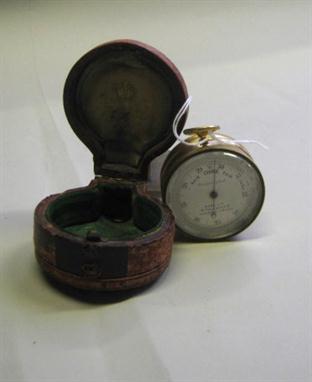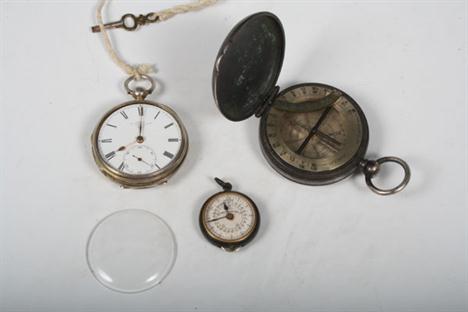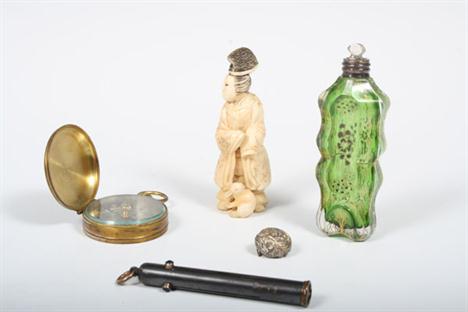36562 Preisdatenbank Los(e) gefunden, die Ihrer Suche entsprechen
36562 Lose gefunden, die zu Ihrer Suche passen. Abonnieren Sie die Preisdatenbank, um sofortigen Zugriff auf alle Dienstleistungen der Preisdatenbank zu haben.
Preisdatenbank abonnieren- Liste
- Galerie
-
36562 Los(e)/Seite
19th Century Sunderland lustre ware bowl decorated with ships and compass, a Japanese Kutani twin handled jar (lacking cover), together with a faience bowl of fluted form decorated with a sailboat, a small faience drug jar and a 19th Century black transfer decorated mug bearing the name Hannah
An English lacquered brass and ivory portable compass microscope Unsigned, late 18th century With threaded loop to take the choice of two lenses (one mounted with a silvered lieberkuhn mirror) mounted on shaped square section upright with screw threaded ivory handle and mounted with pivoted specimen forceps, 12.5cm long assembled, with original silk lined red leather covered traveling case, 14.5cm long.
An Austrian brass universal equinoctial compass sundial J. Schablas, Vienna, 19th century The circular plate with central compass signed J. Schablas in Wien 56 within bezel calibrated in degrees, beneath hinged three-quarter Roman numeral chapter ring annotated IV-XII-VIII with folding pin gnomen and calibrated elevation arc, on three screw adjusting feet, diameter 15cm.
An English patinated brass small garden sundial Unsigned, probably late 17th century The 6 inch square plate with rose engraved star centre annotated with the points of the compass within Roman numeral chapter ring ranging IIII-XII-VII and with stylised wheatear half hour markers, the outer track with divisions for the quarters and eighths, the angles with tulip decorated spandrels within herringbone border to edges, the centre applied with angled gnomen with scroll pierced decoration, 9cm high.
A brass bound mahogany cased `Mansfield Patent Water Finder` W. Mansfield & Co., Liverpool, early 20th century The brass-edged box with glazed aperture to top enclosing a circular opaque glass scale with central pin-pivot for the magnetised steel needle and inscribed MANSFIELDS PATENT AUTOMATIC WATER FINDER Co., LIVERPOOL with scale sector annotated 40-0-40 degrees to far edge, the front with hinged flap to allow access for installing the pivoted steel needle, complete with leather carrying strap, leather outer case containing two cased needles, folding mahogany tripod and OBSERVATIONS log book, (pocket compass lacking), the instrument 26cm high.
A very rare mahogany cased aneroid barocyclonometer or `Typhoon Barometer` Schmidt & Ziegler, Remscheid, to a design by Jose Algue, Manilla, early 20th century The box opening to reveal Faura pattern aneroid barometer with 6 inch circular silvered register calibrated in both barometric inches and millibars and inscribed TYPHOON-BAROMETER by JOSE ALGUE S.J. Director of MANILLA OBSERVATORY, SCHMIDT & ZIEGLER, REMSCHEID to centre, within adjustable outer scale annotated for the Northern hemisphere with latitudes 0-25 opposing 25-32 grouped with appropriate pressure readings for different seasons to the lower half, the upper half annotated with typhoon predictions, the whole set into brass plate numbered 317, the lid of the box applied to the inside with patinated brass and glass CYCLOMETER with central bevelled glass plate scribed with direction arrows and applied with two pointers one engraved with scale 0-100 the other with pivoted direction indicator, the whole rotating within a circular plate annotated with the points of the compass and with repeat signature, the exterior of the box with shaped brass nameplate to top and visible dovetail joints to corners, 22cm wide, 12cm high. This remarkable instrument was the culmination of the efforts of two successive Jesuit Priest directors of the Manilla Observatory, Federico Faura and Jose Algue. The problem of predicting destructive typhoons, which took dozens of lives each year in the Phillipines, led to Faura`s research and eventual publication of his paper Senales precursoras de un temporal in 1882. He then went onto develop the `Faura` pattern barometer which through use of a carefully devised scale could predict with a fair degree of accuracy the proximity of a typhoon. Jose Algue, who succeeded Faura in 1897, undertook further research to devise a method of forecasting the direction from which a typhoon would approach. This led to the development of his `cyclonometer` or `wind disc`. The incorporation of both instruments into one unit was termed a `baroclclonometer`, examples of which were utilised throughout the Phillipines saving countless lives during the opening years of the 20th century. In 1912 Jose Algue was invited by the U.S. government to devise a version of his tried and tested barocylonometer for use in the Northern hemisphere in order to assist in the prediction of Hurricanes and Atlantic storms. In August 1912 he visited New York and Washington where it was agreed that a model calibrated for the Northern hemisphere would be made in Germany for trial onboard Connecticut flagship of Rear Admiral Osterhaus -commander of the Atlantic Squadron for U.S. Navy. By January 1913 Algue was in London where discussions regarding the production of further models in London took place. An account of his visit to New York was published in The New York Times August 18th 1912, and a review of the instrument was published in Popular Mechanics January 1913 issue. The current lot is probably from the very early series of German made models as specified for the order for the U.S. Navy. Another later model (dating to circa 1928) by H. Hughes & Son, London is in The National Maritime Museum collection in Cornwall.
West (William) [Symbolaeography...or the Paterne o 2 parts in 1 second edition issue with Book I added lacks title A2 and [2]A1 collation of last 4 ff. unclear but apparently complete corner of first and last few ff. frayed some marking and browning name obliterated on A3 early marginalia 3 preliminary blank ff. with early notes including legal forms and a large compass later bibliographic note on front free endpaper booksellers stamp on paste-down later half calf worn rebacked [STC 25267.7 3 copies only] 8vo Richard Tottle 1592.
A lacquered brass hand held sighting compass by B.J. Hall & Co Ltd, 23 Victoria Street, London SW, with octagonal barrel, 6.25ins overall, and wooden case for same, a plated metal planimeter by Crosby Steam Gauge & Valve Company, London, 10ins overall, in fitted case, a selection of draughtsman’s instruments, in fitted cases, and a large quantity of other instruments, various
An Early 19th Century Masonic Rose Croix of The Knights of the Pelican and Eagle, Sovereign Prince Rose Croix of the 18th Degree neck badge. Centred with a red paste cross on a radiant silver gilt and Masonic compass ground, surmounted with a green and white paste five point crown and a Pelican in her piety to the lower section. With a border of white pastes. To the reverse a silver rose. 10cm high. Fitted case by Burckhardt of Berkeley Square, by appointment to the Duke of Sussex. The Duke was appointed Grand Master of the premier grand lodge of England and the United grand lodge of England in 1813 and died in 1843.
-
36562 Los(e)/Seite

















































